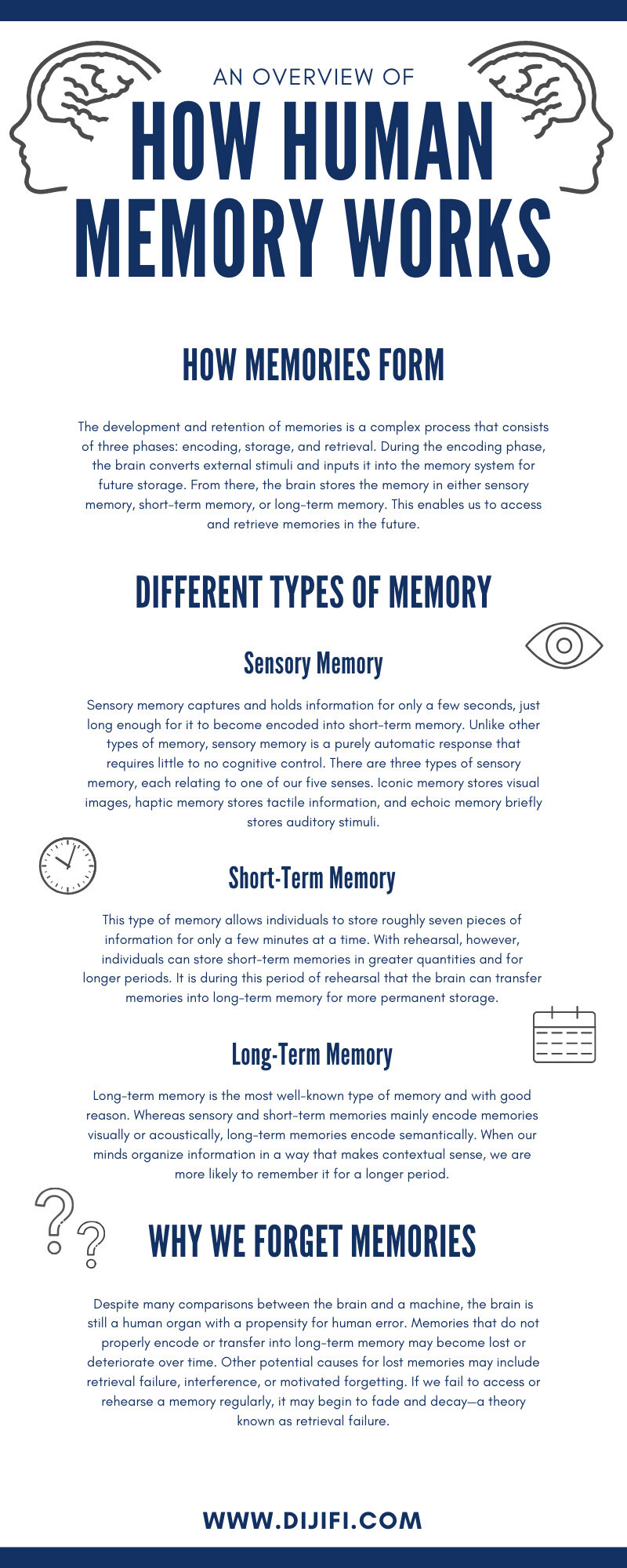An Overview of How Human Memory Works
The inner workings of the human mind are an enigma. For centuries, psychologists and doctors alike have attempted to understand the intricacies of human thought, emotion, and memory. Our knowledge and understanding of the human brain have advanced significantly throughout history; scientists are now better able to pinpoint which areas in our brains are responsible for specific functions. One such function is the ability to create and retain highly specific and intricate memories. In this brief overview of how human memory works, we will discuss the different stages of memory, how they form, and why we sometimes forget them.
How memories form
There are still many unknowns regarding the specific functions and capabilities of the brain. However, scientists can pinpoint which areas of the brain may be responsible for the creation and retention of memory. The brain splits into four sections, with the frontal and parietal lobes playing the largest role in memory development. Other parts of the brain, including the hippocampus, amygdala, and cerebellum, also play an important role in memory. The cerebellum, which resides at the base of the brain, works to encode complex memories. It also plays a large role in the formation of procedural memory. This a type of long-term memory that enables us to perform tasks without conscious awareness of doing so, such as driving a car or riding a bike. The hippocampus also aids in the formation of new memories but focuses more on memories of experienced events, otherwise known as episodic memories. This part of the brain also works to encode emotional context received from the amygdala—the part of the brain responsible for mediating the effects of emotion on memory. Extreme emotional reactions can impact the consolidation of memories into long-term memory, and the amygdala works to mediate this possibility.
The development and retention of memories is a complex process that consists of three phases: encoding, storage, and retrieval. The first step in creating a memory is encoding. During this phase, the brain converts external stimuli and inputs it into the memory system for future storage. From there, the brain stores the memory in one of the memory stages explained below. This enables us to access and retrieve memories in the future. Retrieval refers to our ability to recall stored information in response to external stimuli. Malfunctions in any of these phases can lead to forgetfulness and even amnesia. Additionally, damage to any parts of the brain responsible for memory, including the amygdala, hippocampus, and cerebellum, can lead to problems with long- and short-term memory formation and retrieval.
Different types of memory
We do not form or store all memories in the same way. The encoding, storage, and retrieval process for all memories will depend on the events of the memory in question. There are three different types of memory, each storing and encoding memories in a different manner.
Sensory memory
Sensory memory is by far the shortest type of memory. Sensory memory captures and holds information for only a few seconds, just long enough for it to become encoded into short-term memory. Unlike other types of memory, sensory memory is a purely automatic response that requires little to no cognitive control. Sensory memory mainly works to take in and make sense of external stimuli and determines which moments should transfer into longer-term memories. Because short-term memory operates in such a quick period, it is responsible for our ability to identify and recall images within only a few seconds of observation. There are three types of sensory memory, each relating to one of our five senses. Iconic memory stores visual images, haptic memory stores tactile information, and echoic memory briefly stores auditory stimuli.
Short-term memory
Short-term memory also referred to as working memory, is shorter than most people realize. This type of memory allows individuals to store roughly seven pieces of information for only a few minutes at a time. With rehearsal, however, individuals can store short-term memories in greater quantities and for longer periods. It is during this period of rehearsal that the brain can transfer memories into long-term memory for more permanent storage.
Long-term memory
Long-term memory is the most well-known type of memory and with good reason. The brain can store memories in long-term memory in much larger quantities and can keep them for a significant amount of time. In some cases, memories stored in long-term memory can last a lifetime. The reason for this lies in the way long-term memories become encoded. Whereas sensory and short-term memories mainly encode memories visually or acoustically, long-term memories encode semantically. When our minds organize information in a way that makes contextual sense, we are more likely to remember it for a longer period. Episodic and autobiographical memory also play a large part in long-term memory. At their core, episodic and autobiographical memories may appear very similar, as they both refer to memories of specific moments in time. The main difference between these two types of memory, therefore, lies in our experience. Autobiographical memories refer to events and personal experiences from one’s own life, and episodic memories refer to events that one observes second-hand.
Why we forget memories
Despite many comparisons between the brain and a machine, the brain is still a human organ with a propensity for human error. Memories that do not properly encode or transfer into long-term memory may become lost or deteriorate over time. Other potential causes for lost memories may include retrieval failure, interference, or motivated forgetting. If we fail to access or rehearse a memory regularly, it may begin to fade and decay—a theory known as retrieval failure. Interference, on the other hand, suggests that some memories may interfere with others, causing us to misremember or completely forget certain memories. Head injuries, specifically those that impact the frontal and parietal lobes, or the cerebellum, hippocampus, or amygdala, may also cause the loss of memories.
The human brain is a complex, yet sometimes unreliable, system, and as such, even the most precious memories become lost to time. To preserve memories indefinitely, many people turn to photographs. However, physical photographs can be just as fickle as memories and can easily become damaged or lost to time. To preserve their memories indefinitely, many people convert photos to digital copies. If you want your photos to last longer than your memories, our team at DiJiFi can help you preserve your photos and the memories they hold.


